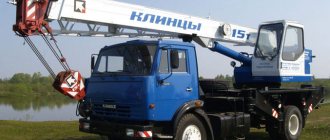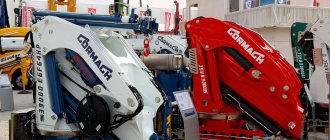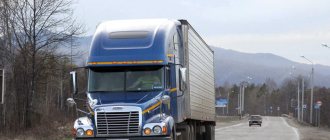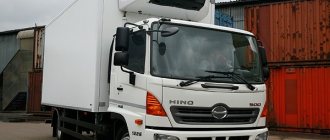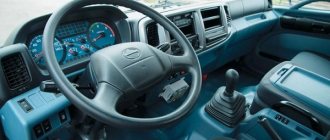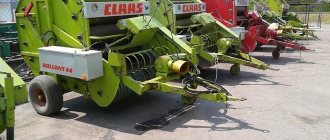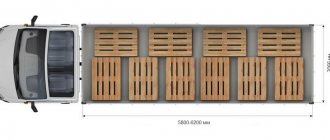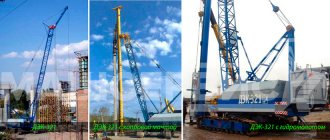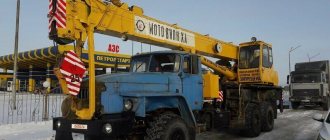Structural nuances of the boom
This part of the tap is shaped like a parallel section. Load capacity is a determining factor when choosing durable equipment.
The boom extension system, based on the telescope principle, is made in the form of sections that move either randomly or in a sequential order. When choosing, it is important to pay attention to such values as the width and length of the platform, as well as the outriggers used. Safety and the amount of cargo that a crane can lift depend on these technical means.
This is interesting: How to obtain rights to a manipulator (CMU): categories, certificates, permits
Chassis
The type of chassis is determined by the scope of application of the crane and the tasks being solved. According to the type of running device used, manipulators are divided into:
- automotive manipulators;
- pneumatic;
- tracked;
- on a special automobile-type chassis;
- short wheelbase;
- on the chassis of a wheeled or crawler tractor;
- rail - on a support platform moved along rails on wheels;
- railway - on railway platforms;
- adjustable;
- trailed, incl. on a sled chassis;
- self-aligning;
- installed permanently on the foundation (for example, on technological sites);
- installed on floating platforms, boats, etc.
The information provided will help you navigate the market and make the right choice if you decide to buy a crane or a ready-made crane.
Advantages
The main advantage of this type of special equipment is its versatility, which allows using the CMU to carry out loading and unloading operations with cargo for various purposes (including loading and transporting containers, cabins, bulk cargo, evacuation of vehicles, etc.), as well as transporting them to the desired location on your own loading platform. Some modifications of this equipment make it possible to install additional equipment on the CMU (installation cradle, excavator bucket, etc.) for various repair and construction work, which further expands its functionality.
Depending on the operating conditions and the nature of the cargo being transported, the crane manipulator mechanism can be installed on virtually any model of truck with a wheeled or tracked chassis, as well as on other types of self-propelled special equipment. To operate in urban environments, such installations are usually installed on light- or medium-duty trucks, which have fairly high maneuverability on urban highways and are economical to operate.
Additional advantages that the crane manipulator has also include:
- low weight and dimensions of the crane mechanism installed on the equipment;
- low cost of crane work and transportation of various cargoes;
- connecting the CMU to the main engine of the vehicle through the power take-off box;
- the possibility of using this special equipment for various types of work.
This device usually includes the following main elements:
- CMU support frame, fixed to the base chassis of the vehicle;
- open cargo platform;
- sectional or telescopic crane mechanism;
- CMU drive from the main engine through a special power take-off;
- operator console to control the operation of the installation.
Terminology
A manipulator crane is a machine for lifting loads, consisting of a crane manipulator unit (CMU), installed on a running device or permanently.
In turn, a crane-manipulator installation is a lifting device that includes boom working equipment, load-handling elements (usually a hook suspension), a control system and a support frame. Most often, the working body does not have a hydraulic drive.
The hydraulic manipulator, on the contrary, is a lifting mechanism that works with hydraulic tools (grabs, grabs, etc.). As a rule, this term is used when talking about timber trucks, metal trucks, garbage trucks and other specialized equipment where working equipment is used for transshipment of materials.
Structurally, the first section of the hydraulic manipulator boom is long, and the second is short, with a telescopic part. This does not allow them to be placed in a folded transport position behind the cab. Usually, during transportation, they are installed on a special support, turned forward or backward, along the direction of movement.
There are also reverse Z designs where the top boom is on top and the load handle is on top. This allows the hydraulic manipulator to be compactly placed when folded behind the cabin, but the low load moment limits their use. In various sources, the authors do not adhere to strict terminology, and although from a technical point of view this is not always correct, the concepts of crane and hydraulic manipulator are often identified.
South Korean manipulators
All types of loader cranes produced in South Korea have an excellent price-quality ratio. They pose serious competition to their Japanese counterparts.
The Kanglim company produces all types of manipulators, including heavy ones. Hydraulic cylinders of our own design are used in production.
Manipulator Kanglim
Dong Yang crane manipulators use additional rear supports and wide balancers, which makes the crane resistant to tipping.
All types of products from relatively young companies CS Machinery and Soosan are no less in demand.
Structural nuances of the boom
This part of the tap is shaped like a parallel section. Load capacity is a determining factor when choosing durable equipment.
The boom extension system, based on the telescope principle, is made in the form of sections that move either randomly or in a sequential order. When choosing, it is important to pay attention to such values as the width and length of the platform, as well as the outriggers used. Safety and the amount of cargo that a crane can lift depend on these technical means.
Characteristics of the CMU
Listed below are the most basic characteristics that characterize the crane and determine its cost:
- maximum and minimum boom radius;
- load capacity at maximum and minimum reach;
- load moment of the boom, also set at the largest and smallest variants of the crane boom reach;
- lifting heights and release of the load;
- smaller radius of the crane installation;
- implementation of suspension.
The design of the boom plays an important role:
- parallel section shape. The more edges, the stronger it is. Therefore, it is necessary to choose it with a large number of edges;
- image of a telescopic extension system. Such sections can be shifted either in a sequential order or in a random order;
- load capacity is an important element;
- the length and width of the platform, the outriggers used. The crane’s lifting capacity and the safety of the work will depend on them.
Please note that when selecting a manipulator, you must look at the load height diagram, which is an important element on which visibility depends.
This is interesting: KamAZ-based manipulator: models and characteristics
Selection rules
To rent a manipulator without unpleasant consequences for the customer, first of all, you will need to pay attention to:
- Tonnage of the vehicle, taking into account the performance of the boom. The weight of the load must not exceed the permissible load on the manipulator.
- Arrow functionality. Specifically, the parameters of reach, lift power and maneuverability are important.
- Vehicle characteristics. The overall dimensions of the CMU platform must not only meet the stated requirements of the lessee, but also the parameters of the transportation object.
- CMU operator. Regardless of the functional characteristics, the professionalism of the driver of a boom vehicle is quite important.
When filling out an application for the selected manipulator, it is recommended to pay attention to the documentation provided by the carrier organization.
Classification by load capacity and load moment
Depending on the load capacity, CMUs are conventionally divided into the following 3 classes:
- up to 1 ton (this class includes machines called micromanipulator cranes);
- from 1 to 10 tons (medium-capacity cranes);
- more than 10 tons (heavy cranes).
However, lifting capacity is somewhat a subjective indicator, since its value does not reflect the dependence of the actual maximum weight of the load being lifted on the boom reach. Therefore, it would be more correct to talk about the cargo moment. This parameter is the product of two factors: boom radius and CMU load capacity. The units of measurement for this indicator are kNm (kilonewton per meter) and tm (ton per meter). As such, there is no generally accepted classification of CMU for this parameter. For this reason, you can rely on the experience of enterprise developers. For example, the Austrian manufacturer Palfinger classifies its own machines into 3 groups:
- light class (load moment no more than 3.9 tm);
- middle class (load torque ranging from 4 to 29.9 tm);
- heavy class (load moment in the range from 30 to 150 tm).
A different classification of CMU models is offered by the Swedish manufacturer of special equipment HIAB, dividing its machines as follows:
- light class (load moment less than 10 tm);
- middle class (load moment from 10 to 22 tm);
- heavy class (load moment – 22 tm or more).
Results
A manipulator crane, the rental of which is quite expensive compared to conventional trucks, is an almost universal technique for loading and unloading various types of cargo. Obtaining a permit to transport oversized cargo on the CMU platform is a painstaking and costly process, both in time and financially. Therefore, before ordering a vehicle with a lifting boom from a transport organization, you should carefully check the validity periods of all accompanying documents. Control of even the smallest nuances will reduce the risk of unpleasant situations, consequences, as well as the financial costs of eliminating them. A balanced decision in choosing a vehicle for transportation means a lot for both the performer and the recipient.
Features of transportation of various types of building materials by road.
Views: 8,336
Control system
The control system in machines of this type is usually represented by a set of levers, each of which is responsible for a specific action, be it raising the boom, extending outriggers, raising or lowering the cable, etc. Often the controls are located at the base of the boom on both sides of the base of the CMU .
However, it is not uncommon for manufacturers to place these arms at the top of the boom base where the operator's seat is located. Models of cranes produced today are often equipped with remote control panels that allow you to control the operation of the cranes from a distance.
Outriggers
Outriggers are retractable supports that are installed on the ground during loading and unloading operations, thereby ensuring the necessary stability of the base machine. Loader cranes use outriggers that differ in the method of extension, which can be mechanical or hydraulic.
In the first case, the outriggers are extended manually. After installation on the ground, the outriggers are fixed in the desired position.
The hydraulic method of extending outriggers involves the use of compact hydraulic cylinders driven by a hydraulic motor of a manipulator crane. Outriggers of this type are equipped with cranes with high lifting capacity.
Classification of manipulator cranes
Based on the type of suspension used, there are cranes with a boom on a rigid suspension (hinged version) and with a boom on a flexible suspension (rope version). In the latter case, the load is grabbed using a load hook located at the end of the winch. If the suspension is rigid, then the location of the hook is hinged, on the head of the boom.
Based on how the boom folds, CMUs are divided into three types:
- Z-shaped;
- L-shaped;
- telescopic.
When the arrows are folded, their shape resembles these particular Latin letters. Telescopic ones extend from each other - an arrow of a smaller diameter - from an arrow of a larger diameter.
Types of auto-manipulators:
- low-tonnage (easy to operate and maintain, light weight, good flexibility due to two knees and a load capacity of up to seven tons, mounted on small trucks, retractable supports are hydraulically driven);
- medium-tonnage (carry loads weighing up to 25 tons, boom length is 20 meters, mounted on large trucks);
- large-tonnage (carry loads up to 80 tons, mounted on super-heavy trucks, semi-trailers).
Types of CMU for KAMAZ trucks
Any type of loader crane can be installed on a Kamaz truck. One condition is that the manipulator should not weigh more than 15% of the weight of the Kamaz. Models of loader cranes made in South Korea and Japan have proven themselves well when installed at KamAZ.
Types of robotic manipulators:
- used in mining. It is a drill carriage that moves in the bottomhole space;
- used in the metallurgical industry to perform auxiliary manipulations during metal forming. There are forging and rolling types. This type of cranes, such as overhead cranes, is used in rolling and forging shops;
- used in nuclear technology for working with radioactive substances;
- used in oceanographic work at great depths. They are equipped with hydrostats.
Another type of parallel robotic arm is the Hugh-Stewart platform. This type involves the use of an octahedral rack arrangement. With its help, machine tools are made; it is actively used in aviation, in underwater research, on flight simulators, in telescopes, and also in orthopedics.
Types of CMU by brand:
- PALFINGER;
- FERRARI;
- XCMG;
- HIAB;
- PM;
- FASSI;
- EFFER;
- Sinegorets;
- Epsilon Palfinger;
- KANGLIM;
- NANSEI;
- TADANO;
- KATO;
- UNIC.
For each type of work and for each vehicle, you can choose your own crane that will meet all the requirements.
Boom equipment
There are two main parameters: the type of suspension and the method of folding the boom equipment.
- flexible. The design of the CMU is rope-based; a winch cable is used to move loads. The load is grabbed by a hook attached to this cable;
- tough. CMUs with such a suspension have a hydraulically controlled lifting mechanism. It is secured to the boom using hinge joints.
Folding methods can be as follows.
L-shaped
With this design, the boom is straight and extends telescopically. When folded, it is located along the side of the chassis in the body area or above the driver’s cabin. Such boom equipment operates using a winch, which allows the load to be lowered and raised smoothly and with high precision. Another advantage is optimal load distribution (part of it is shifted to the rear axle). This increases the lifting capacity of the equipment.
Z-shaped
With this design, the boom consists of several bends, which allows it to be folded compactly behind the cabin. The "cranked" design also makes it easier to work in difficult conditions where there are obstacles. On the other hand, such equipment has a reduced load capacity. It is believed that it is advisable to use it for working with loads of relatively small mass.
Based on experience, in Moscow there is more demand for renting a manipulator with an L-shaped boom - it is more reliable and productive, and in addition, it is more affordable.
Application
The machine ideally copes with the mechanization of loading and unloading operations, and therefore can be used for lifting, loading and further transportation of both single objects and cargo located on pallets and pallets, as well as in containers. With the help of these machines, you can successfully transport small-piece cargo, machine tools, change houses, glass, logs and other long items, metal scrap and even cars that are in faulty or emergency condition. In addition, such machines are widely used in the following cases:
- when performing installation and high-altitude work;
- in low-rise construction;
- in public utilities;
- when performing repair and restoration work;
- when carrying out work in cramped conditions.
Delivery organization
Still, most standard cargo is transported using conventional trucks. Transportation of oversized, bulky or heavy objects requires preliminary consideration and approval from regulatory authorities.
Therefore, when drawing up a travel route, it must be analyzed and submitted for approval to road safety control services.
Preparatory activities are carried out taking into account the following criteria:
- details of the loading and unloading of the vehicle;
- transportation kilometers;
- characteristics of the cargo (length, width, height, volume and other values);
- marking of cargo by hazard class, if any;
- exact coordinates of loading, unloading and reloading points;
- serviceability of the road surface along the entire length of the route;
- the presence of complex or bottlenecks in the passage of crane trucks with oversized cargo, detour routes;
- reliability of fastenings for the fixation scheme of the transported object on the manipulator platform;
- proper placement of cargo in the body of the crane in accordance with the regulations for the transportation of oversized cargo;
- appropriate marking of the vehicle and cargo, warning other road users about the type of cargo being transported.
Also among the mandatory points for drawing up the route, it is worth noting the accuracy of the location of control points for inspection of cargo and vehicles, as well as their distance from populated areas.
